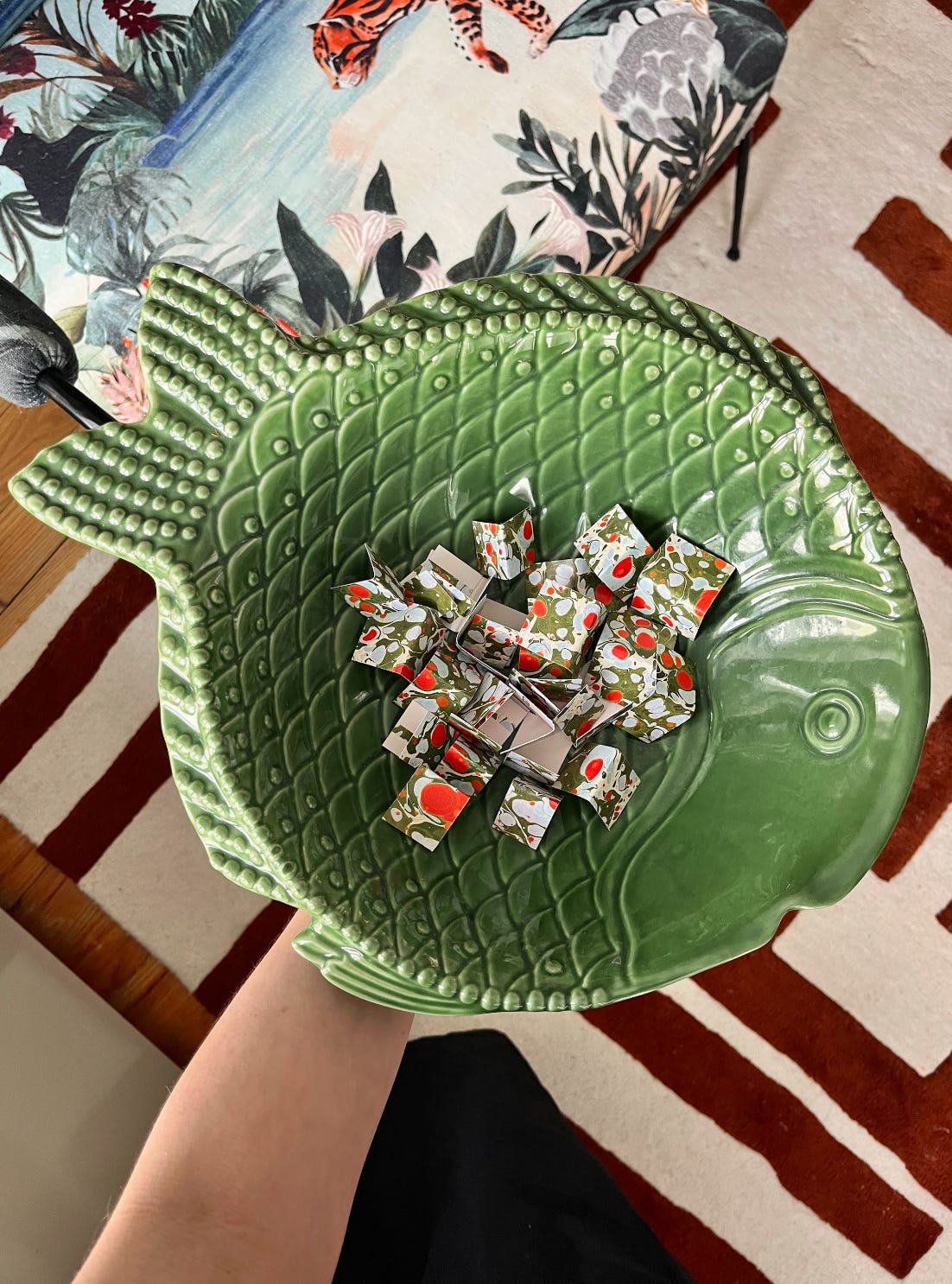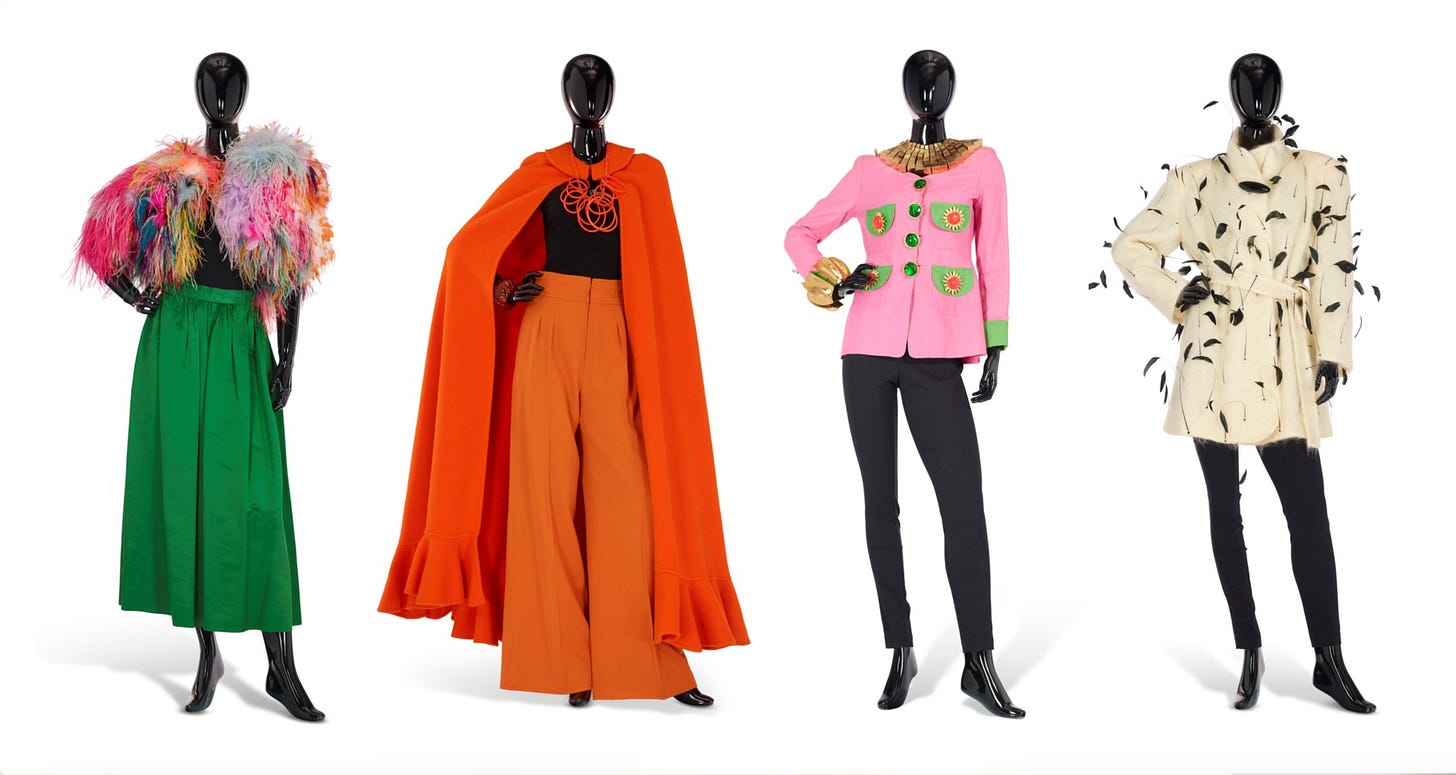This is Cocktail Charm, a weekly email filled with delicious little things to talk about at parties. In today’s edition: snoafer sneakerinas, Apfellian auctions, and a very good boy.
Game it out
I shook the fish-shaped serving bowl in my hands, making the folded slips of paper in it tumble and leap. I’d cut them at my kitchen island earlier that day, snipping sheets into rectangles the size of fortune cookie divinations. As my casserole crisped in the oven, I consulted the list I’d made and started scrawling.
An hour later, girls had gathered in swaying groups in the living room, bobbing together like tropical schools in the reeds. I moved from group to group, offering each the bowl as I explained the rules. “Take a piece of paper,” I said. “On every sheet is a little-known fact about someone else here. Your job is to find them before the end of the party.”
I’d gotten the idea from an anecdote inside one of my favorite books about getting people together. Trained in conflict resolution, Priya Parker spent much of her career as a professional facilitator specializing in high-stakes meetings. Part event director, part temp-taker, and part stranger soothsayer, Parker would put together gatherings where outcomes were consequential and emotions could run high — think a diplomatic sit-down between two tense nations trying to rebuild trust, or an interfaith student dialogue addressing heated campus politics. Eventually, she spun off what she learned into a book. But The Art of Gathering isn’t just for UN officials or student dissidents. Inside, Parker argues that most of us hold unsatisfying get-togethers — missing intention, not impressed with meaning, and leaving people feeling lacking afterwards — and establishes her own framework for having better gatherings. I read it in 2020 and still think about it regularly.
Parker’s professional opinion is that every gathering — a friend’s big birthday party, a teammate’s new-job sendoff, or that pet iguana’s holy baptism — needs a purpose. Why are you getting people together, and what do you want them to take away with them after the party lights have dimmed? If you can impart your intention in a sentence, even better.
Which brings me back to my living room. We were at my annual Galentine’s brunch, which I’ve been holding just about every year since 2017. I’d always enjoyed inviting girlfriends from different corners of my life to my living room — a setting more loose than a restaurant sit-down, less raucous than a big night out, and equally breezy and buzzing as either. And since reading Parker’s book, I’d named a purpose that had been part of the gathering all along: to introduce women I love and admire to other women I love and admire.
Every choice you make, Parker imparts, should be in service of that purpose. Who do you invite, and who do you exclude? (Pretty obvious: narrowing the guest list down by gender kept the group more intimate and open to introduction.) Where will your gathering happen, and where will it not? (A good question: The living room was key to keeping us all together and ready to bump into someone new. If I opened up the bedroom, too, people could divide into silos — and have literal walls between themselves and someone new.) Last, once invitations have been accepted and guests arrive, what will you do there? Enter, controversially to ME, the party game.
In her book — and excellent newsletter all about gathering — Parker includes lots of anecdotes illustrating how to plug her ideas into your next party. For years I’d thought of one wedding someone had once told her about. I dug out my copy to find it.
I’m usually hesitant about a party game. To me, dropping them in without expectation — time for bingo! charades! guessing games! — can come off as gimmicky, cornball, hack. Come on. Can’t we trust our people to have a good time getting to know each other organically?
But if I were serious about giving this brunch purpose, I reasoned, I should try one. If I could prompt people to break away from their instinctive bubbles — to not seek out the guests they knew in my living room and stick with them — my brunch would be the better for it.
When I sent invitations to the brunch about a month beforehand, I made a brief request with the RSVP. “Tell me a fun fact I don’t already know about you,” I wrote. “You’ll find out why when you get here!”
And dang, did the answers deliver. I learned how my close friend had survived a short career as a baby model. That an acquaintance held the key to a small city in Ohio. That my cousin’s high school teacher rerouted a class field trip so she could try her first cheeseburger. I wrote their admissions on my paper slips, then offered them around.
Some guests took to the competitive nature of the challenge at once. H, who so far had clustered with a number of her work friends that morning, headed over to M and K, sorority sisters I’d bonded with in college. “I’m wondering if anyone here has been a vegetarian before!” she said. “I’m H.” (Close, no cigar, et al: my burger-trying cousin was on the other side of the room.)
For others, getting a task emboldened them to wander into a new group when they’d have otherwise found it difficult. P, who’d gamely arrived alone, had found friendly strangers as soon as she’d arrived, then stuck with them. She took the elbow of one of her new companions, glad for the excuse to have someone float around with her. “Let’s go figure out who played alto sax in the marching band,” she said.
The game, as it was, started throwing out lines of connection between my friends like macramé art. Winding around the room, we actually found two baby models in the group (guilty). We realized quite a few people had been a member of the high school band. There were smaller recognitions, too: we had three Sarahs in the room, a reality I hadn’t realized as I’d looked over my guest list, and one that might have passed unnoticed if a game hadn’t compelled everybody to mingle and weave.
Even I, who hadn’t been playing, found an unexpected bonus for myself: The slips gave me a break from hosting. By the early afternoon, the small clusters of chat had given way to one shared circle around my living room. Here’s the thing I’ve learned with a room’s worth of attention on one group conversation: without concurrent chatter happening around you, you’ll eventually hit a moment of awkward silence. It a host’s darkest dread, and when I’m the party marshal, I make it my job to fill those spaces. I stand at the edge ready to toss out a question about what everyone thought of the new HBO show I’m trying, or turn to someone to tell us about that new acro-yoga class I knew they tried last week. But this time, when quiet fell, someone else piped in. “Who hasn’t found their fun fact yet?” she said. “Let’s all solve it together.”
Now I have to ask: Party games. Are you into them? Cringe at them? Changed your mind on them? Drop me a line with your opinion — or the best one you’ve ever played.
Tell me about it
Conversation-starters to take to happy hour (or your group chat).
Are you hibernating your hair for winter? Vogue says the Olsen Tuck — i.e. keeping your hair under a big sweater, scarf, or coat, much like Mary-Kate and Ashley — was all over New York Fashion Week. As the story points out, this is Phoebe Philo erasure. But I clocked Meghan Markle doing it in her big return to Instagram this month, too.
Snoafer or sneakerina? Listen, the ballet sneaker has been mainstream since at least last spring. But I do have to admire this Guardian fashion columnist for shoving as many sartorial portmanteaus (snoafer! jegging! skouser!) as she can in this story about its rise.
Can anyone tell me why they killed the Duolingo owl? The fact that I’m asking about it means this dumb dummy dumb marketing is working.
Sorry, what exactly is Himalayan Viagra? The cordyceps sinensis — a wild mushroom considered a cure-all medicine and (possible) aphrodisiac — goes by the name “caterpillar fungus,” sells in Beijing for $136,000 a pound, and has produced a fierce industry of sex mushroom hunters. You simply have to read about it.
DEPARTMENT OF INTERLUDES
Today marks the last day of fashion magpie Iris Apfel’s estate sale, and these jackets are obscenely cocktail-coded. Write me back and tell me which outfit you’d bid on.
One thing I couldn’t stop asking everyone I met this week
Wasn’t it a great week for coats? Obviously I’m referring to the Westminster Dog Show. If I were giving the prizes: Best Blowout goes to Louis the Afghan Hound (NYT); Most Cumulous is awarded to Schmutzie the Samoyed (Gothamist); and Best in Content belongs to, as always, city documentarian New York Nico (Instagram).
I also really loved Town and Country’s roving sketch artist who produced a diary of illustrations from the sidelines of the show.
Backtalk
In last week’s email, I asked if any of you have said yes to a blind social arrangement. A lovely, insightful reply from my brother:
I met a close friend in 2018 from a happy hour hosted by the Nancy podcast that ran on WNYC. They ran a series on the difficulty of making a group of queer friends, and they backed it up with mixers to find people who, at the very least, had a similar media diet! Sean and I connected because we swapped Spotify screens, and saw we had a bunch of other podcasts in common. It transformed into a great friendship for the next few years, and showed me that I could make friends out in the wild over shared interests.
A case for the hyper-niche mixer! Go get ‘em.
Last chatter
Just about every city interiors influencer I’ve followed for the last few years (many) spent the pandemic installing renter-friendly picture frame molding in their apartment. But I’m genuinely refreshed by this painterly version featured in the Design Hunting column this week — in the home of artist Scott Csoke, faux frames are applied with a whimsical touch of trompe l’oeil. I say the owner of some Village martini bar should call up Csoke to place a commission within the week.
Clink clink!
Gabriela
Thanks for being a reader of Cocktail Charm! Has this newsletter helped you out at happy hour? Let me know; I’d love to hear it.














